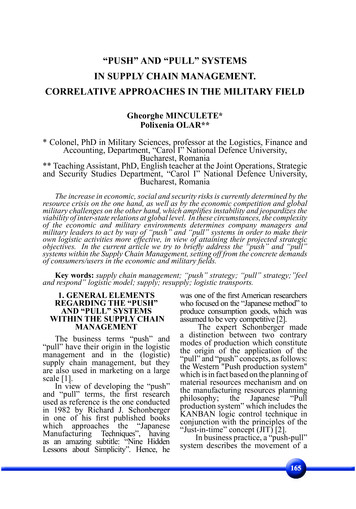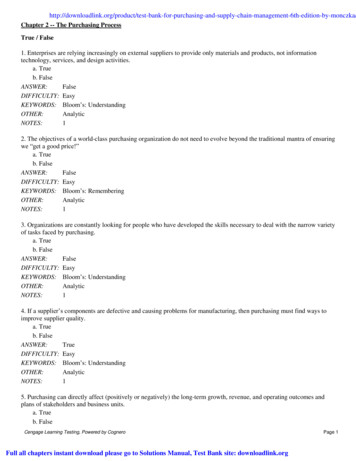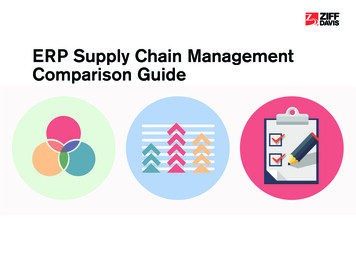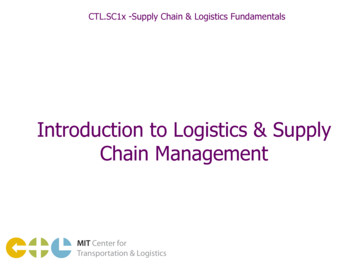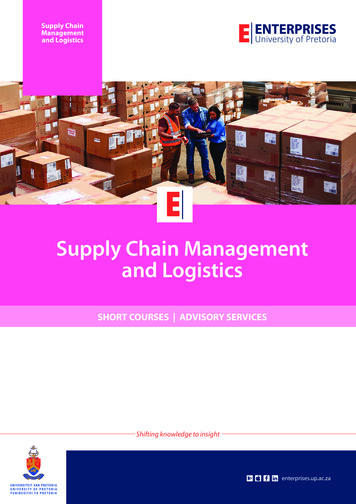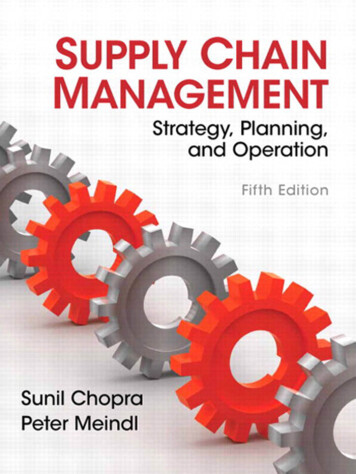
Transcription
Fi f t h E d i t i o nSupply Chain ManagementSTRATEGY, PLANNING, AND OPERATIONSunil ChopraKellogg School of ManagementPeter MeindlKepos CapitalBoston Columbus Indianapolis New York San Francisco Upper Saddle RiverAmsterdam Cape Town Dubai London Madrid Milan Munich Paris Montreal TorontoDelhi Mexico City Sao Paulo Sydney Hong Kong Seoul Singapore Taipei Tokyo
Editorial Director: Sally YaganEditor in Chief: Donna BattistaSenior Acquisitions Editor: Chuck SynovecEditorial Project Manager: Mary Kate MurrayEditorial Assistant: Ashlee BradburyDirector of Marketing: Maggie MoylanExecutive Marketing Manager: Anne FahlgrenProduction Project Manager: Clara BartunekManager Central Design: Jayne ConteCover Designer: Suzanne BehnkeManager, Rights and Permissions: Estelle SimpsonCover Art: FotoliaMedia Project Manager: John CassarMedia Editor: Sarah PetersonFull-Service Project Management: Abinaya Rajendran,Integra Software Services Pvt. Ltd.Printer/Binder: Edwards Brothers, Inc.Cover Printer: Lehigh / Phoenix - HagerstownText Font:Times 10/12 Times RomanCredits and acknowledgments borrowed from other sources and reproduced, with permission, in this textbook appearon the appropriate page within text.Microsoft and/or its respective suppliers make no representations about the suitability of the information contained inthe documents and related graphics published as part of the services for any purpose. All such documents and relatedgraphics are provided “as is” without warranty of any kind. Microsoft and/or its respective suppliers hereby disclaim allwarranties and conditions with regard to this information, including all warranties and conditions of merchantability,whether express, implied or statutory, fitness for a particular purpose, title and non-infringement. In no event shallMicrosoft and/or its respective suppliers be liable for any special, indirect or consequential damages or any damageswhatsoever resulting from loss of use, data or profits, whether in an action of contract, negligence or other tortiousaction, arising out of or in connection with the use or performance of information available from the services.The documents and related graphics contained herein could include technical inaccuracies or typographicalerrors. Changes are periodically added to the information herein. Microsoft and/or its respective suppliers may makeimprovements and/or changes in the product(s) and/or the program(s) described herein at any time. Partial screen shotsmay be viewed in full within the software version specified.Microsoft and Windows are registered trademarks of the Microsoft Corporation in the U.S.A. and other countries.This book is not sponsored or endorsed by or affiliated with the Microsoft Corporation.Copyright 2013, 2010, 2007, 2004, 2001 by Pearson Education, Inc., publishing as Prentice Hall. All rightsreserved. Manufactured in the United States of America. This publication is protected by Copyright, andpermission should be obtained from the publisher prior to any prohibited reproduction, storage in a retrievalsystem, or transmission in any form or by any means, electronic, mechanical, photocopying, recording, or likewise.To obtain permission(s) to use material from this work, please submit a written request to Pearson Education, Inc.,Permissions Department, One Lake Street, Upper Saddle River, New Jersey 07458, or you may fax your request to201-236-3290.Many of the designations by manufacturers and sellers to distinguish their products are claimed as trademarks. Wherethose designations appear in this book, and the publisher was aware of a trademark claim, the designations have beenprinted in initial caps or all caps.Library of Congress Cataloging-in-Publication DataChopra, Sunil,Supply chain management : strategy, planning, and operation / Sunil Chopra, Peter Meindl.—5th ed.p. cm.ISBN-13: 978-0-13-274395-2 (alk. paper)ISBN-10: 0-13-274395-7 (alk. paper)1. Marketing channels—Management. 2. Delivery of goods—Management. 3. Physical distribution of goods—Management. 4. Customer services—Management. 5. Industrial procurement. 6. Materials management.I. Meindl, Peter. II. Title.HF5415.13.C533 2013658.7—dc23201103726910 9 8 7 6 5 4 3 2 1ISBN 10:0-13-274395-7ISBN 13: 978-0-13-274395-2
DedicationI would like to thank my colleagues at Kellogg for all that I have learned fromthem about logistics and supply chain management. I am grateful for the loveand encouragement my parents, Krishan and Pushpa, and sisters, Sudha andSwati, have always provided during every endeavor in my life. I thank mychildren, Ravi and Rajiv, for the joy they have brought me. Finally, none of thiswould have been possible without the constant love, caring, and support of mywife, Maria Cristina.—Sunil ChopraI would like to thank three mentors—Sunil Chopra, Hau Lee, and GerryLieberman—who have taught me a great deal. Thank you also to my parentsand sister for their love, and to my sons, Jamie and Eric, for making me smileand teaching me what life is truly all about. Most important, I thank my wife,Sarah, who makes life wonderful and whom I love with all of my heart.—Pete MeindlABOUT THE AUTHORSSUNIL CHOPRASunil Chopra is the IBM Distinguished Professor of Operations Management andInformation Systems at the Kellogg School of Management. He has served as the interimdean and senior associate dean for curriculum and teaching, and the codirector of theMMM program, a joint dual-degree program between the Kellogg School of Managementand the McCormick School of Engineering at Northwestern University. He has a Ph.D. inoperations research from SUNY at Stony Brook. Prior to joining Kellogg, he taught atNew York University and spent a year at IBM Research.Professor Chopra’s research and teaching interests are in supply chain and logisticsmanagement, operations management, and the design of telecommunication networks.He has won several teaching awards at the MBA and Executive programs of Kellogg.He has authored more than 40 papers and two books.He has been a department editor for Management Science and an associate editor forManufacturing & Service Operations Management, Operations Research, and DecisionSciences Journal. His recent research has focused on understanding supply chain risk anddevising effective risk mitigation strategies. He has also consulted for several firms in the area ofsupply chain and operations management.PETER MEINDLPeter Meindl is with Kepos Capital. Previously, he was a research officer with BarclaysGlobal Investors, a consultant with the Boston Consulting Group and Mercer ManagementConsulting, and the director of strategy with i2 Technologies. He holds a Ph.D., M.S., B.S.,and B.A. from Stanford, and an M.B.A. from the Kellogg School at Northwestern.The first edition of this book won the prestigious Book of the Year award in 2002 from theInstitute of Industrial Engineers.
CONTENTSPreface xPart IBuilding a Strategic Framework to Analyze SupplyChainsChapter 1 UNDERSTANDING THE SUPPLY CHAIN 11.11.21.31.41.51.61.7What Is a Supply Chain? 1The Objective of a Supply Chain 3The Importance of Supply Chain Decisions 4Decision Phases in a Supply Chain 6Process Views of a Supply Chain 8Examples of Supply Chains 13Summary of Learning Objectives 17Discussion Questions 17 Bibliography 18Chapter 2 SUPPLY CHAIN PERFORMANCE: ACHIEVING STRATEGICFIT AND SCOPE 192.12.22.32.42.5Competitive and Supply Chain Strategies 19Achieving Strategic Fit 21Expanding Strategic Scope 32Challenges to Achieving and Maintaining Strategic Fit 34Summary of Learning Objectives 36Discussion Questions 36 Bibliography 37Chapter 3 SUPPLY CHAIN DRIVERS AND METRICS3.13.23.33.43.53.63.73.83.93.1038Financial Measures of Performance 38Drivers of Supply Chain Performance 41Framework for Structuring Drivers 43Facilities 44Inventory 47Transportation 49Information 51Sourcing 54Pricing 56Summary of Learning Objectives 58Discussion Questions 59 Bibliography 59왘 CASE STUDY: Seven-Eleven Japan Co. 60왘 CASE STUDY: Financial Statements for Wal-Mart Stores Inc. 66iv
ContentsPart IIDesigning the Supply Chain NetworkChapter 4DESIGNING DISTRIBUTION NETWORKSAND APPLICATIONS TO ONLINE SALES 684.14.24.34.44.54.6The Role of Distribution in the Supply Chain 68Factors Influencing Distribution Network Design 69Design Options for a Distribution Network 73Online Sales and the Distribution Network 86Distribution Networks in Practice 99Summary of Learning Objectives 100Discussion Questions 101 Bibliography 101왘 CASE STUDY: Blue Nile and Diamond Retailing 102Chapter 5NETWORK DESIGN IN THE SUPPLY CHAIN 1085.15.25.35.45.55.6The Role of Network Design in the Supply Chain 108Factors Influencing Network Design Decisions 109Framework for Network Design Decisions 114Models for Facility Location and Capacity Allocation 116Making Network Design Decisions in Practice 132Summary of Learning Objectives 133Discussion Questions 134 Exercises 134 Bibliography 139왘 CASE STUDY: Managing Growth at SportStuff.com 139왘 CASE STUDY: Designing the Production Network at CoolWipes 141Chapter 6DESIGNING GLOBAL SUPPLY CHAIN NETWORKS6.16.26.36.46.56.66.76.8143The Impact of Globalization on Supply Chain Networks 143The Offshoring Decision: Total Cost 145Risk Management in Global Supply Chains 148Discounted Cash Flows 152Evaluating Network Design Decisions Using Decision Trees 153To Onshore or Offshore: Evaluation of Global Supply ChainDesign Decisions Under Uncertainty 161Making Global Supply Chain Design Decisions UnderUncertainty in Practice 170Summary of Learning Objectives 170Discussion Questions 171 Exercises 171 Bibliography 173왘 CASE STUDY: BioPharma, Inc. 174왘 CASE STUDY: The Sourcing Decision at Forever Young176Part III Planning and Coordinating Demand and Supplyin a Supply ChainChapter 7DEMAND FORECASTING IN A SUPPLY CHAIN 1787.17.2The Role of Forecasting in a Supply Chain 178Characteristics of Forecasts 179v
nts of a Forecast and Forecasting Methods 180Basic Approach to Demand Forecasting 181Time-Series Forecasting Methods 183Measures of Forecast Error 193Selecting the Best Smoothing Constant 195Forecasting Demand at Tahoe Salt 197The Role of IT in Forecasting 203Risk Management in Forecasting 204Forecasting in Practice 205Summary of Learning Objectives 205Discussion Questions 206 Exercises 206 Bibliography 208왘 CASE STUDY: Specialty Packaging Corporation, Part A 208Chapter 8AGGREGATE PLANNING IN A SUPPLY CHAIN 2118.18.28.38.48.58.68.78.88.9The Role of Aggregate Planning in a Supply Chain 211The Aggregate Planning Problem 213Aggregate Planning Strategies 215Aggregate Planning Using Linear Programming 216Aggregate Planning in Excel 224Building a Rough Master Production Schedule 226The Role of IT in Aggregate Planning 227Implementing Aggregate Planning in Practice 228Summary of Learning Objectives 228Discussion Questions 229 Exercises 229 Bibliography 231왘 CASE STUDY: Specialty Packaging Corporation, Part BChapter 9231SALES AND OPERATIONS PLANNING: PLANNING SUPPLYAND DEMAND IN A SUPPLY CHAIN 2349.19.29.39.49.5Responding to Predictable Variability in the Supply Chain 234Managing Supply 235Managing Demand 237Implementing Sales and Operations Planning in Practice 244Summary of Learning Objectives 245Discussion Questions 245 Exercises Bibliography 248왘 CASE STUDY: Mintendo Game Girl 248246Chapter 10 COORDINATION IN A SUPPLY CHAIN 25010.110.210.310.410.510.6Lack of Supply Chain Coordination and the Bullwhip Effect 250The Effect on Performance of Lack of Coordination 252Obstacles to Coordination in a Supply Chain 254Managerial Levers to Achieve Coordination 258Continuous Replenishment and Vendor-Managed Inventories 263Collaborative Planning, Forecasting, and Replenishment 264
Contents10.7 Achieving Coordination in Practice 26710.8 Summary of Learning Objectives 269Discussion Questions269 Bibliography270Part IV Planning and Managing Inventories in a Supply ChainChapter 11 MANAGING ECONOMIES OF SCALE IN A SUPPLY CHAIN:CYCLE INVENTORY 27111.111.211.311.411.511.611.7The Role of Cycle Inventory in a Supply Chain 271Estimating Cycle Inventory–Related Costs in Practice 274Economies of Scale to Exploit Fixed Costs 276Economies of Scale to Exploit Quantity Discounts 289Short-Term Discounting: Trade Promotions 300Managing Multiechelon Cycle Inventory 305Summary of Learning Objectives 307Discussion Questions 308 Exercises 308 Bibliography 310왘 CASE STUDY: Delivery Strategy at MoonChem 311Appendix 11A: Economic Order Quantity 313Chapter 12 MANAGING UNCERTAINTY IN A SUPPLY CHAIN: SAFETYINVENTORY 31412.112.212.312.412.512.612.712.812.9The Role of Safety Inventory in a Supply Chain 314Determining the Appropriate Level of Safety Inventory 316Impact of Supply Uncertainty on Safety Inventory 327Impact of Aggregation on Safety Inventory 329Impact of Replenishment Policies on Safety Inventory 341Managing Safety Inventory in a Multiechelon Supply Chain 344The Role of IT in Inventory Management 345Estimating and Managing Safety Inventory in Practice 346Summary of Learning Objectives 347Discussion Questions 348 Exercises 348 Bibliography 351왘 CASE STUDY: Managing Inventories at ALKO Inc. 351왘 CASE STUDY: Should Packaging be Postponed to the DC?353Appendix 12A: The Normal Distribution 354Appendix 12B: The Normal Distribution in Excel 355Appendix 12C: Expected Shortage Cost per Cycle 356Appendix 12D: Evaluating Safety Inventory for Slow-MovingItems 357Chapter 13 DETERMINING THE OPTIMAL LEVEL OF PRODUCTAVAILABILITY 35813.1 The Importance of the Level of Product Availability 35813.2 Factors Affecting Optimal Level of Product Availability 35913.3 Managerial Levers to Improve Supply Chain Profitability 370vii
viiiContents13.4 Setting Product Availability for Multiple Products UnderCapacity Constraints 38413.5 Setting Optimal Levels of Product Availability in Practice 38613.6 Summary of Learning Objectives 387Discussion Questions 388 Bibliography 390 Exercises388Appendix
Supply chain management : strategy, planning, and operation / Sunil Chopra, Peter Meindl.—5th ed. p. cm. ISBN-13: 978-0-13-274395-2 (alk. paper) ISBN-10: 0-13-274395-7 (alk. paper) 1. Marketing channels—Management. 2. Delivery of goods—Management. 3. Physical distribution of goods— Management. 4. Customer services—Management. 5. Industrial procurement. 6. Materials






